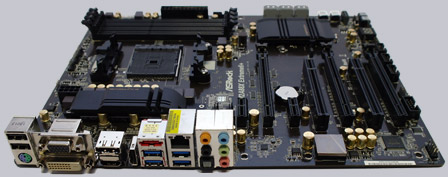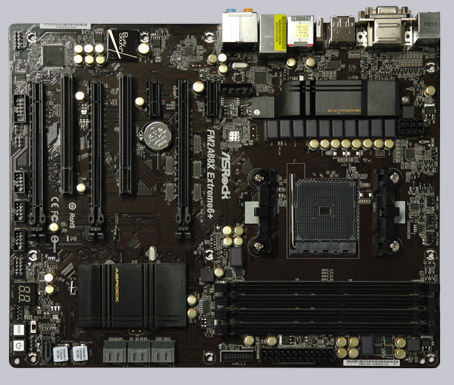
Result and general impression

++++ The ASRock FM2A88X Extreme6+/A/ASRK motherboard has a price of approx. 85 Euro (12/2013) and is thus in the middle price segment of the Socket FM2+ motherboards.
Today, we test the first motherboard with the new Socket FM2+ for AMD Kaveri processors at OCinside.de that is also backward compatible with Socket FM2 Richland and Trinity processors. The AMD FM2+ motherboard based on the AMD A88X Bolton-D4 chipset and has a total of five PCI Express slots, two PCI slots, four memory slots with AMP and XMP support, seven SATA3 ports, one eSATA3 port, Gigabit LAN, HDMI-In, HDMI output, D-Sub VGA, DVI, DisplayPort, 7.1 purity sound and lots of more features. Of course we have not just tested the ASRock FM2A88X Extreme6+ Socket FM2+ mainboard features, but also overclocked it up to the limits.
In this cardboard box the ASRock FM2A88X Extreme6+ FM2+ motherboard is delivered:
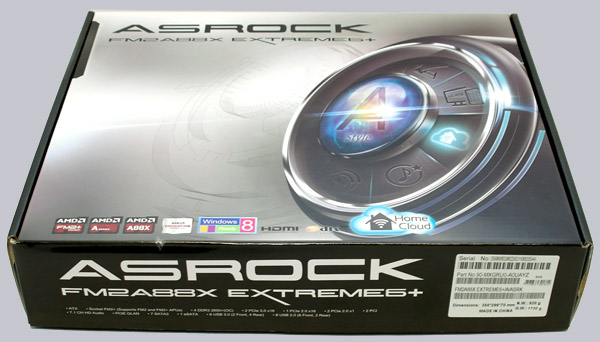
Here is a first look at the included accessories:
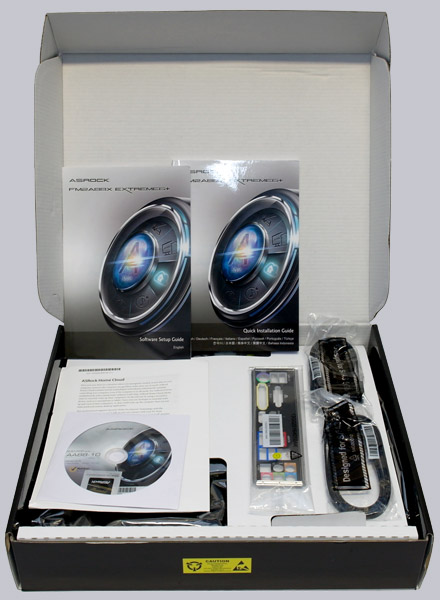
The board was carefully wrapped for safe delivery with foam and fastened with cable ties:
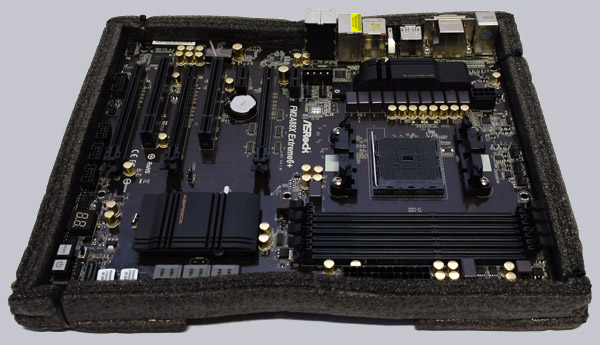
The ASRock FM2A88X Extreme6+ is very well finished, has durable Premium Gold Caps capacitors, offers Digi Power VRM and 8+2 Power Phase Design for FM2 processors up to 100W and FM2+ processors up to 95W and 7.1 Purity Sound with Realtek ALC1150 Audio Codec:
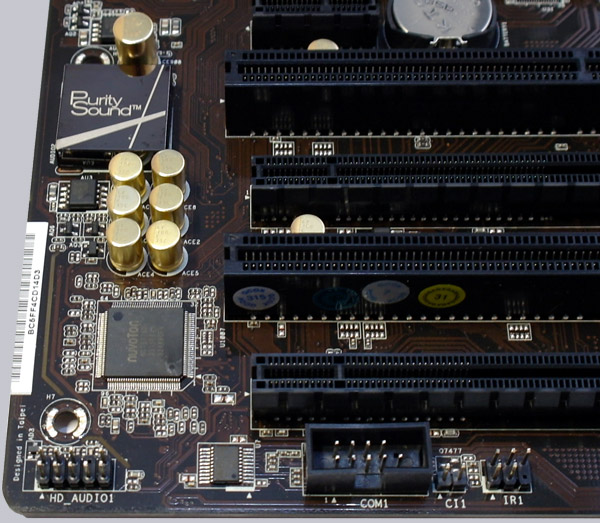
Here we can see the LED illuminated power and reset buttons, the two UEFI BIOS ICs with the A/B BIOS switch and the 7-segment post code display, which can be disabled in the BIOS on demand right after the start, since it is usually only helpful during the boot process:
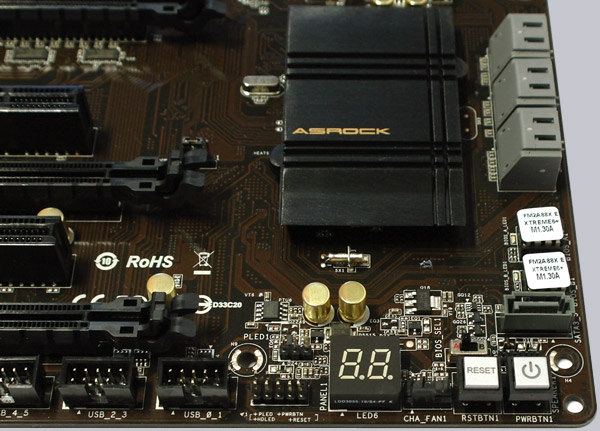
And this is the new Socket FM2b or Socket FM2+, which has compared to the Socket FM2 2 pins more and remains thus fortunately backward compatible to the FM2 Socket:
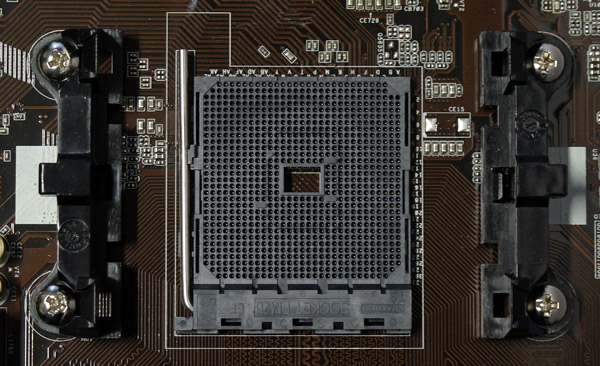
Equipment and other features …
The FM2A88X Extreme6+ motherboard from ASRock came with a manual, software setup guide, one DVD, four SATA data cables and ATX I/O shield. USB Slot brackets or the ASRock 3.5-inch USB3.0 frontpanel are optional available.
This mainboard offers a lot of features and has a lot of addons, like for example the ASRock A-Tuning Tool, ASRock Instant Flash, ASRock Internet Flash, ASRock APP Charger, ASRock Instant Boot, ASRock Restart to UEFI, ASRock XFast USB, ASRock XFast LAN, ASRock XFast RAM, ASRock Crashless BIOS, ASRock Online Management Guard, ASRock UEFI System Browser, ASRock Dehumidifier Function, ASRock Easy RAID Installer, ASRock Easy Driver Installer, ASRock interactive UEFI, ASRock UEFI Tech Service, ASRock Good Night LED, ASRock USB Key Remote Power On, ASRock Home Cloud, Purity Sound, HDMI-In, ASRock FAN-Tastic Tuning and more.
Expansion cards …
The 3-Way CrossFireX motherboard offers two PCI Express 3.0 (with a FM2 CPU/APU PCI Express 2.0) video card slots and another PCI Express 2.0 video card slot, whereby either one video card can operate with x16 band-width, or two with x8 lanes or two with x8 lanes and one in x4 mode. If one like only use one video card on the FM2A88X Extreme6+, one should insert the PCI Express video card into the PCIe2 slot to get the fastest x16 bandwidth. Additionally to the three PCI Express slots there are two x1 PCIe 2.0 slots and two PCI slots.
Memory …
The ASRock FM2A88X Extreme6+ can be equipped with up to four DDR3 modules and is expandable depending upon operating system used (see list) to maximally 64 GB memory.
Here you can see the four DDR3 sockets with Dual Channel support:
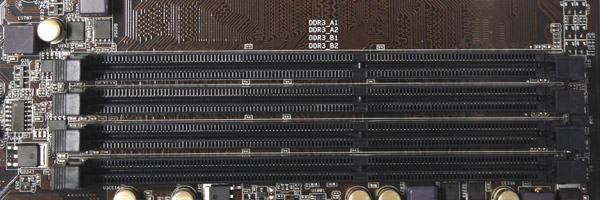
The Socket FM2 motherboard supports DDR3 memory modules and can be optimized in the BIOS for DDR3-800, DDR3-1066, DDR3-1333, DDR3-1600, DDR3-1866, DDR3-2133, DDR3-2400 and faster Dual Channel modules. DDR3-2600 or higher clock-rates are currently only possible with overclocking and official just with two modules. Thanks to AMP (AMD Memory Profile) and XMP (Intel eXtreme Memory Profiles) support, AMP/XMP memory modules are set correctly with one mouse click in the UEFI.
Hard disk drive connectors …
The FM2A88X Extreme6+ offers one straight and six bent SATA3 connectors (6 Gb/s) and an additional eSATA3 port at the I/O panel. The Serial ATA III ports supports RAID 0, RAID 1, RAID 5, RAID 10, NCQ, AHCI and the Hot Plug function in AHCI mode (AHCI stands for Advanced Host Controller Interface and can be selected in the BIOS / UEFI BIOS). The UEFI BIOS support drives with more than 2TB for a Windows8, Windows 7 x64 or Vista x64 installation.
Here you can see the six bent SATA ports and to the left both BIOS ICs:
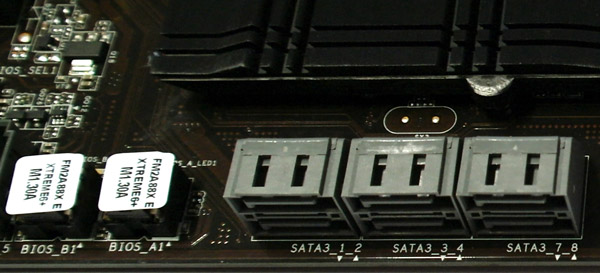
The manual and the included DVD contains all basic information to manage a new installation of Windows XP, Windows Vista Windows 7 or Windows 8 with SATA3 drives, and how to make a RAID installation. 32-Bit and 64-Bit drivers for Windows XP, Windows Vista Windows 7 and Windows 8 are provided on the DVD and can be downloaded on the ASRock support page.
USB and Firewire …
The motherboard has four USB 3.0 connectors on the ATX-panel (2x AMD A88X und 2x ASMedia ASM1042), two USB 2.0 connectors on the ATX panel, three internal USB 2.0 plugs for up to six optional USB ports and one internal USB 3.0 plug for up to two optional USB 3.0 ports. The special 20-pin connector can be connected for example to an optional USB3.0 frontpanel or to a PC chassis with 20-pole USB3 connector.
Here is a picture of the internal 20-pin USB connector:
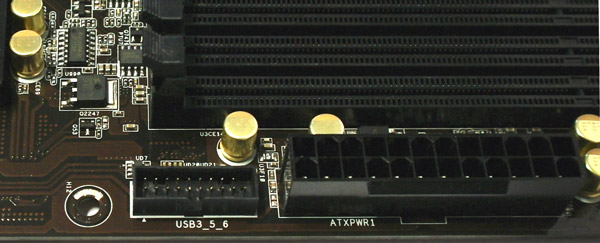
Hint: One should install the latest ASRock XFast USB software to accelerate the USB transfer rate e.g. for USB sticks clearly. Who uses Windows 7 or Windows 8, should also install the ASRock XFast RAM software, which we have discussed already several times in some forum posts.
Network …
The ASRock FM2A88X Extreme6+ motherboard is provided with the Qualcomm Atheros AR8171 chip which offers a 10/100/1000 network connector on the I/O panel. The LAN connection is WoL capable, offers LAN cable detection and supports the Qualcomm Atheros Security Wake On Internet Technology, PXE and energy efficient 802.3az ethernet.
Serial and parallel port …
The motherboard does not provide a parallel port. A serial port is optionally available as internal onboard connector.
Sound …
The ASRock FM2A88X Extreme 6+ motherboard is equipped with the ALC1150 audio codec with content protection, 115dB SNR DAC, TI NE5532 Premium Headset Amplifier and Purity Sound, which supports 7.1 surround sound for example analog over 5x 3.5mm connectors on the ATX panel or over an internal frontpanel audio connector. Furthermore, there is an optical digital SPDIF output, DTS Connect support and premium Blu-Ray audio support. So most users do not need to buy an additional sound card with digital outputs.
Graphics …
The AMD A88X chipset offers in combination with a Richland, Trinity or Kaveri APU processor a full integrated graphics solution with DX11 or DX11.1 support. Depending upon processor used there is an AMD Radeon HD 8000 or HD 7000 graphics unit, whereby the AMD A10-5800K CPU used in this test is equipped with the AMD Radeon HD7660D graphics unit and the additional evaluated AMD A10-6800K CPU offers an integrated AMD Radeon HD8670D GPU.
The AMD HD7660D and HD8670D has also without overclocking a high performance. So the GPU of the AMD A10-6800K APU achieved in Windows 7 with 3DMark06 7823 3DMarks and the AMD A10-5800K APU achieved in Windows 7 with 3DMark06 7721 3DMarks ! In comparison, the HD6550D GPU of the AMD A8-3870K FM1 APU reached on the ASRock A75 Pro4 Motherboard 6181 3DMarks and an Intel HD Graphics Unit of the Intel Core i5-2500K CPU on an ASRock H77 Pro4/MVP achieved with 3DMark06 in Windows 7 a benchmark score of 4310 3DMarks. An AMD HD 4290 IGP of an AMD 890GX chipset achieved with an AMD Phenom II 710 X3 processor for example a score of 2204 points in 3DMark06 (tested with an ASRock 890GX Extreme4). Furthermore the integrated video processor supports DirectX 11 and with a FM2+ DirectX11.1, supports HDCP, Full HD 1080p and offers thanks to the onBoard HDMI connector and the low power consumption optimal conditions for a HTPC, but more on that in the energy consumption comparison test below.
A very special feature of this FM2A88X Extreme6+ motherboard is the additional HDMI-In port, which allows the connection of an external HDMI device like another PC, a cable or satellite receiver or a Smartphone with HDMI output.
Here is the graphics output to the left and the HDMI-IN Input to the right:
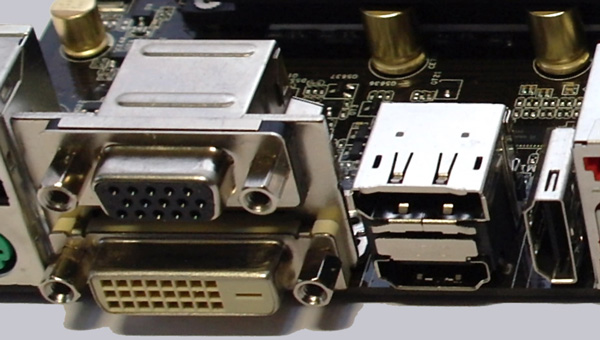
One can switch between the PC picture and the external HDMI device during operation using the key combination ALT + C, which can be changed with the A-Tuning program in HDMI-IN -> Hotkey. Nice to see, that ASRock integrated this great feature to this board as well.
ATX backpanel connectors …
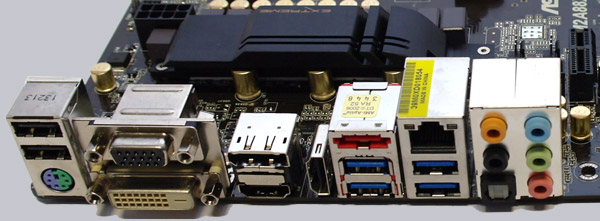
From left to right one can see 2x USB 2.0 and 1x PS/2 connectors for PS/2 keyboard or PS/2 mouse, 15-pol Sub-D VGA and DVI-D VGA, DisplayPort and HDMI Output, HDMI Input, eSATA3 and 2x USB 3.0 (ASMedia ASM1042), RJ45 Gigabit LAN and 2x USB 3.0 (AMD A88X), optical SPDIF out and 5x 3.5mm jacks for analog sound.
BIOS Overclocking …
Let us continue with BIOS / UEFI options and UEFI overclocking. By pressing F2 or Del, you get access to the UEFI with all important hardware settings.
The ASRock UEFI BIOS of the FM2A88X Extreme6+ offers a graphical surface for an intuitive operation with a mouse or with a keyboard, depending upon desire. User with an USB mouse and USB keyboard should not deactivate the Legacy USB support in the BIOS with the USB Configuration, because otherwise they can not access the UEFI Setup. In the Auto mode the board decides if the USB device need to operate in Legacy mode. Keyboard and Mouse should be still connected to the USB 2.0 ports.
Another feature is the “Active Page on Entry” selection, where you can decide which UEFI page you like to see when you enter the UEFI Setup. This is mainly very helpful for overclocking, since one have to visit the second OC Tweaker menu very often to find the best OC settings, so ASRock helps you to save a few mouse clicks.
Here is a screenshot of the UEFI BIOS setup with the new Active Page on Entry selection:
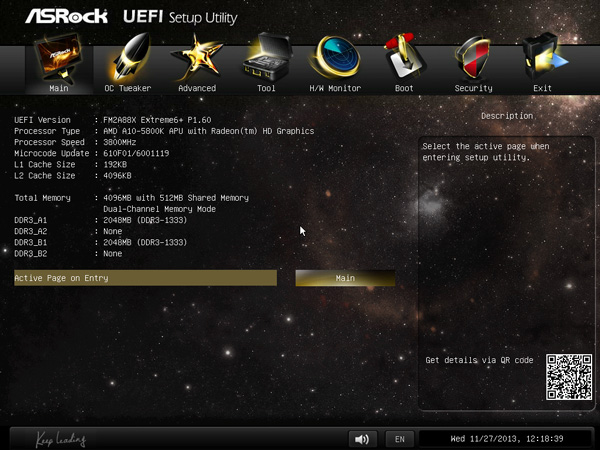
UEFI BIOS Update …
ASRock offers again very comfortable ways to flash BIOS updates, like e.g. the very easy ASRock Instant Flash or the latest ASRock Internet Flash with a direct internet connection.
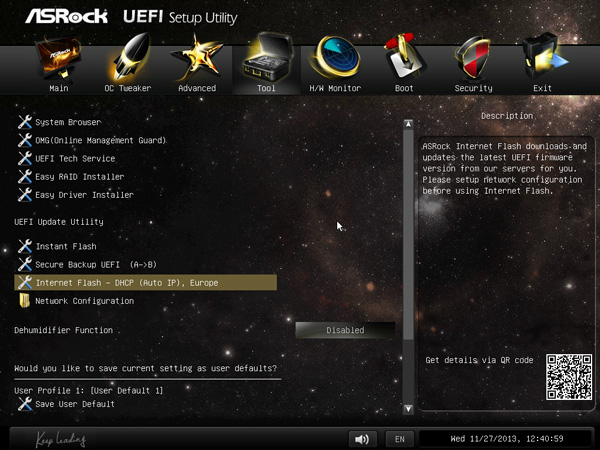
On this Tool page, two more useful features RAID Installer and Easy Driver Installer can be found, to download the needed drivers for the Windows installation very simply, as soon as you have connected an USB thumb drive.
One can enter the ASRock Instant Flash utility in the Advanced Screen or by pressing F6 during the PC start. Hereby one can upgrade a downloaded ASRock BIOS without further boot CD, USB boot stick, etc. very easily. Just start the ASRock Instant Flash utility and select a BIOS Flash ROM from the device like an USB Stick to flash the BIOS without an additional boot medium. If you need technical help about the UEFI, you can contact the ASRock over the UEFI Setup and LAN connection. Furthermore, this motherboard is equipped with a backup BIOS and by the “Secure Backup UEFI” option one can update with a working BIOS from the other BIOS EEPROM and select the preferred BIOS chip at any time over the BIOS selection jumper.
The board came with BIOS M1.30A. At review date, the UEFI BIOS P1.60 was the latest version for download.
How to overclock the ASRock FM2A88X Extreme6+ motherboard …
The FM2A88X Extreme6+ UEFI Setup offers versatile OC-settings for easy overclocking. For DDR3 memory it offers settings like e.g. the memory setting from DDR3-800 over DDR3-1066, DDR3-1333, DDR3-1600, DDR3-1866, DDR3-2133 up to DDR3-2400 or with reference clock OC even higher. The frequency of all memory modules is calculated and shown after changing the reference clock and makes it much easier to adjust the right RAM frequency. Up to DDR3-2400 can be selected in the BIOS and higher DDR3 frequencies over DDR3-2400 are available with reference clock overclocking. It is very advantageous that the FM2A88X ASRock Extreme6 motherboard can read both AMP and XMP profile values from the memory modules and setup the RAM modules for their optimal speed.
The host clock is adjustable from 100 MHz up to 136 MHz and the NB frequency can be adjusted between 5x to 31x, which results in 1000 MHz up to 6200 MHz at default APU/PCIE rating of 100 MHz.
In our tests, it was possible to overclock it up to 136 MHz reference clock (results in 137.28 MHz), which was of course added to our OCinside Team rankings and was a new record at the review date.
Overclocking with the reference clock should be proceed with caution, because some other frequencies are increased by the internal clock generator as well. When overclocking Black Edition processors, so-called “K” APUs with unlocked multiplier, it is more easy to overclock the APU by increasing the multiplier. Anyway, the reference clock is still important at least when you buy high-end OC RAM and like to operate it on the maximum frequency, because this is on most boards only possible with reference clock / APU/PCIE frequency increasement.
The boot failure guard was checked in this review as well and it was possible to start the PC on standard values with too high overclocking settings without using Clear CMOS. ASRock integrated a “Boot Failure Guard Count” option, where the user can decide, how often the board should try to start with too high settings, before it reduces all necessary frequency settings for a correct boot. If one prevents the PC from booting with wrong values, one can press the Clear CMOS button, but the stored profile values are still saved and can be loaded quickly.
Furthermore, this board offers a Vcore setting on the AMD A10 Trinity test CPU from 0.6000 V to 1.5500 V with an Offset of -0,300 bis +0,300, a CPU NB/GFX voltage from 0.6000 V to 1.5500 V, an APU PCIE voltage from 1.208 bis 1.563 V, a SB voltage setting between 1.10 V and 1.40 V and more settings to reach higher overclocking results. Additionally, the board offers an APU and NB Load Line Calibration, which can be set from 100% to 0%. NB and APU Load Line Calibration / LLC offers a compensation of the voltage in Idle/Load CPU load alternation. For manual overclocking of FM2 or FM2+ processors, the CPU Load Line Calibration should be disabled to get higher OC results stable. The DDR3 memory voltage can be set between 1.165 V up to 1.800 V in steps between 0.01 V and 0.0125 V, which should be enough power for some DDR3 OC RAM modules.
If these are too many values for you, one can also easily select a predefined overclocking at boot time with the X button – the so-called ASRock XBoost feature, so that the values can be increased easily without OC know-how by some percent.
We will give you overclocking help in our PC Forum (German and English).
With the CPU Thermal Throttle option, it is possible to lower the CPU frequency on too high internal CPU temperature to protect the CPU from overheating. This is a helpful CPU protection which should be left enabled, but it is still necessary to have a good cooling for overclocking.
As special BIOS feature one can store three different UEFI OC settings with a desired name. Thus one can save for example balanced BIOS settings, overclocking settings and underclocking settings in a user profile of the BIOS to load them very quickly at any time.
Here is a screenshot of the User Profile:
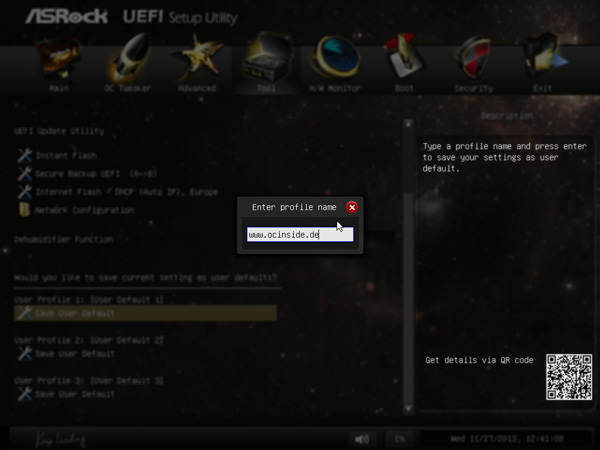
BIOS Undervolting …
The downclocking or underclocking was also tested in this review. It was possible to lower the AMD A10-5800K CPU multiplier over the BIOS to 14x and underclock with 100 MHz reference clock to approx. 1400 MHz.
Underclocking and OverClocking is outside of the manufacturers specification. It’s necessary to have a bit luck, but ASRock give you some useful options to overclock or underclock / undervolt the system more easily.
The BIOS of the passive cooled FM2A88X Extreme6+ motherboard offers a temperature fan control for a 4-pin and a 3-pin CPU fan and a 4-pin chassis fan:
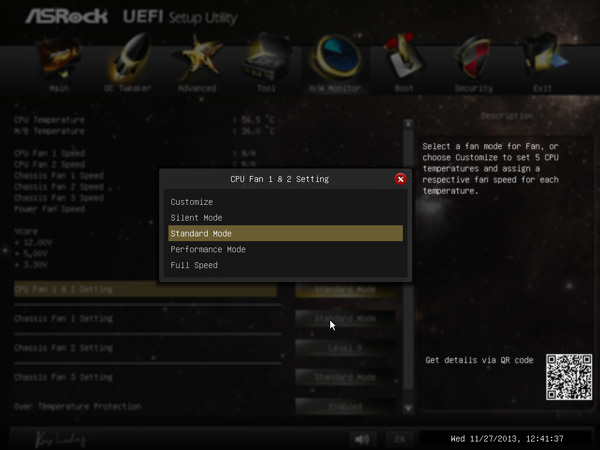
The fan control can also easily set using the ASRock A-Tuning Tool supplied. And also both other fans can be adjusted manually in the UEFI or by software, so it is non-essential to spend money for an additional fan controller.
Power consumption …
Power consumption will vary depending upon the hardware and upon the PC load. The current consumption of the test PC with AMD A10-5800K Black Edition CPU, 4GB DDR3-1333 memory, hard disk drive and Cooler Master Silent Pro M 600W test PSU was without overclocking depending upon load: – With Sapphire HD6870 card the power consumption was between 68.5W and 236.3 Watt. – With internal HD7660D GPU the power consumption was between 33.6W Idle and 130.0W Load.
We tested the same system once again with an AMD A10-6800K Richland APU and achieved the following total PC consumption wattages: – With Sapphire HD6870 card the power consumption was between 56.1W and 237.7 Watt. – With internal HD7660D GPU the power consumption was between 34.2W Idle and 143.3W Load.
Additionally all most important overclocking features and temperature monitoring are available with the included ASRock A-Tuning Software.
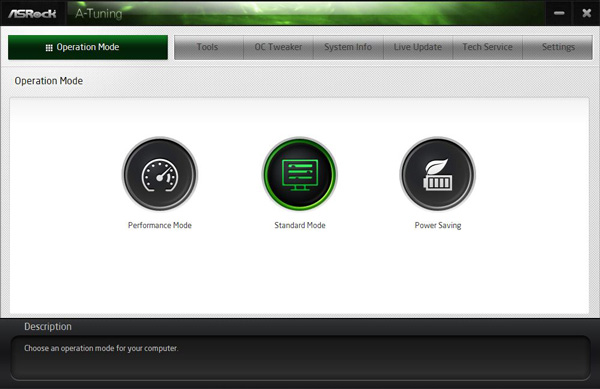
Result …
The ASRock FM2A88X Extreme6+ AMD Socket FM2+ DDR3 motherboard is for AMD Socket FM2+ Kaveri processors up to 95 Watt TDP and previous Trinity or Richland processors up to 100 Watt TDP, has for this low price a remarkably good equipment and reached record levels during overclocking.
The basic equipment of the ASRock FM2A88X Extreme6+ offers seven SATA3 ports with RAID support, one eSATA3 port, up to six possible USB 3.0 ports, up to eight possible USB 2.0 ports, one Gigabit LAN connector, 7.1 purity sound, analog sound output over five 3.5mm jacks, digital sound output over an optical SPDIF connector, a very handy switchable HDMI input by the HDMI-In port and dependig on the processor, it offers a graphics output over HDMI-Out, 15-pin D-Sub, DVI-D or DisplayPort.
All in all the ASRock FM2A88X Extreme6+ is a forward-looking AMD Socket FM2+ motherboard, supporting the current Socket FM2 A4, A6, A8 and A10 processors, as well as upcoming Socket FM2+ Kaveri processors and showed no weaknesses while very high overclocking. So the ASRock FM2A88X Extreme6+ motherboard received the Redaktion ocinside.de Overclocking Dream Award 12/2013 for this amazing result!
Here you can buy the ASRock FM2A88X Extreme6+ motherboard. *Ad
Special thanks to ASRock for their support.
* All Socket FM2+ PCIe motherboard reviews since 01.12.2013 are based on an AMD A10-6800K Black Edition CPU and on an AMD A10-5800K Black Edition CPU,Sapphire HD6870 1024MB ATI Radeon HD6870 PCI Express 2.0 video card, 2x 2048MB Crucial Ballistix Tracer DDR3-1333/PC3-10600 memory modules, Cooler Master Silent Pro M 600W power supply unit and the following software configuration: Microsoft Windows 7 Ultimate, SiSoftware Sandra 2013, Futuremark 3DMark, 3DMark Vantage, 3DMark06 and 3DMark03 (the software is available in the Links & Downloads section). All benchmark results only offer a comparison among themselves for a rough motherboard performance comparison.
Back to the AMD Vishera, Bulldozer, Kaveri, Richland and Trinity motherboard comparison !


